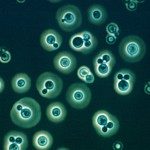Lien vers Pubmed [PMID] – 34392593
Lien DOI – 10.1111/cmi.13385
Cell Microbiol 2021 Aug; (): e13385
Lipid microdomains or lipid rafts are dynamic and tightly ordered regions of the plasma membrane. In mammalian cells, they are enriched in cholesterol, glycosphingolipids, Glycosylphosphatidylinositol-anchored and signalling-related proteins. Several studies have suggested that mammalian pattern recognition receptors are concentrated or recruited to lipid domains during host-pathogen association to enhance the effectiveness of host effector processes. However, pathogens have also evolved strategies to exploit these domains to invade cells and survive. In fungal organisms, a complex cell wall network usually mediates the first contact with the host cells. This cell wall may contain virulence factors that interfere with the host membrane microdomains dynamics, potentially impacting the infection outcome. Indeed, the microdomain disruption can dampen fungus-host cell adhesion, phagocytosis and cellular immune responses. Here, we provide an overview of regulatory strategies employed by pathogenic fungi to engage with and potentially subvert the lipid microdomains of host cells. TAKE AWAY: Lipid microdomains are ordered regions of the plasma membrane enriched in cholesterol, glycosphingolipids (GSL), GPI-anchored and signalling-related proteins. Pathogen recognition by host immune cells can involve lipid microdomain participation. During this process, these domains can coalesce in larger complexes recruiting receptors and signalling proteins, significantly increasing their signalling abilities. The antifungal innate immune response is mediated by the engagement of pathogen-associated molecular patterns to pattern recognition receptors (PRRs) at the plasma membrane of innate immune cells. Lipid microdomains can concentrate or recruit PRRs during host cell-fungi association through a multi-interactive mechanism. This association can enhance the effectiveness of host effector processes. However, virulence factors at the fungal cell surface and extracellular vesicles can re-assembly these domains, compromising the downstream signalling and favouring the disease development. Lipid microdomains are therefore very attractive targets for novel drugs to combat fungal infections.

